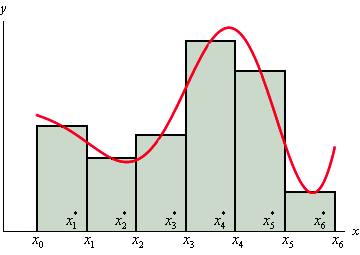Adblocker Detected

We always struggled to serve you with the best online calculations, thus, there's a humble request to either disable the AD blocker or go with premium plans to use the AD-Free version for calculators.
Disable your Adblocker and refresh your web page 😊
An online midpoint rule calculator will allow you to estimate a definite integral using the midpoint rule. Also, this calculator provides the approximation of the area as compared to the left-right rectangle or left rectangle sum. So, keep reading to know how to find the midpoint rule with its formula and examples.
In mathematics, the midpoint rule approximates the area between the graph of the function f(x) and the x-axis by adding the areas of rectangles with midpoints that are points on f(x).

You can use an online Riemann Sum Calculator that will allow you to estimate the definite integral and sample points of midpoints, trapezoids, right and left endpoints using finite sum.
To find the area for different rectangles and so for a general n we get:
$$ ∫^b_a f(x) = Δx (f(\frac{x_0 + x_1} {2}) + f(\frac{x_1 + x_2} {2}) + f(\frac{x_2 + x_3} {2}) + . . . + f(\frac{x_{n-2} + x_{n-1}} {2}) + f(\frac{x_{n-1} + x_n} {2}) ) $$
However, an online midpoint rule calculator solve functions to approximate the integrals using this formula instantly when you input with upper and lower limit.
Midpoint rule Example:
Find the midpoint rule when \( ∫^4_1 \sqrt{x^2 + 4} \), where the number of rectangles is 5.
Solution:
The integral \( ∫^4_1 \sqrt{x^2 + 4} dx \) with n = 5 using midpoint rule.
The midpoint rule formula is:
$$ ∫^b_a f(x) = Δx (f(\frac{x_0 + x_1} {2}) + f(\frac{x_1 + x_2} {2}) + f(\frac{x_2 + x_3} {2}) + . . . + f(\frac{x_{n – 2} + x_{n – 1}} {2}) + f(\frac{x_{n – 1} + x_n} {2}) ) $$
Where Δx = b – a / n
We have a = 1, b = 4, n = 5.
So, Δx = 4 – 1 / 5 = 0.6
Divide the intervals [1, 4] into n = 5 subintervals with the length Δx = 0.6 for the following endpoints:
A = 1, 1.6, 2.2, 2.8, 3.4, 4 = b
A midpoint rule approximation calculator can approximate accurate area under a curve between two different points.
Now, determine the function at the points of the subintervals.
$$ f(\frac{x_0 + x_1} {2}) = f (\frac{1 + 1.6} {2}) = f(1.3) = \sqrt{(1.3)^2 + 4} = 2.3853 $$
$$ f(\frac{x_1 + x_2} {2}) = f (\frac{1.6 + 2.2} {2}) = f(1.9) = \sqrt{(1.9)^2 + 4} = 2.7586 $$
$$ f(\frac{x_2 + x_3} {2}) = f (\frac{2.2 + 2.8} {2}) = f(2.5) = \sqrt{(2.5)^2 + 4} = 3.2015 $$
$$ f(\frac{x_3 + x_4} {2}) = f (\frac{2.8 + 3.4} {2}) = f(3.1) = \sqrt{(3.1)^2 + 4} = 3.6891 $$
$$ f(\frac{x_4 + x_5} {2}) = f (\frac{3.4 + 4} {2}) = f(3.7) = \sqrt{(3.7)^2 + 4} = 4.2059 $$
Now, add the values and multiply by Δx = 0.6
So,
$$ 0.6 (2.3853 + 2.7586 + 3.2015 + 3.6891 + 4.2059) = 9.7444 $$
A midpoint rule calculator gives better approximation of the area using it formula.
However, an Online Integral Calculator will allow you to evaluate the integrals of the functions with respect to the variable involved.
The midpoint rule, Simpson’s rule, and trapezoidal rule are all different methods to approximate the area under the curve. But the question is how do we know which approximation is accurate in comparison to the exact area under the curve?
An error-bound formula can tell us the maximum error in our estimation. So if the error bound is small, then our approximation is close to the actual area. Apart from this, if the error bound is large then our estimation is bad and far away from the actual area.
The midpoint error formula is:
$$ |E_M| < K (b – a)^3 / 24 n^2 |f’’ (x) | < K $$
Where E_m is an actual error for the midpoint rule and n is the number of subintervals for finding the area over the interval [a, b]. f’’ (x) is the second derivative of a given function.
An online midpoint rule approximation calculator helps you to find the size of subintervals using midpoint rule with these steps:
The midpoint method is more precise than the trapezoidal method. This is recommended by the composite error bounds, but they do not rule out the possibility that the trapezoidal may be more accurate in some cases.
When the underlying function is smooth, the trapezoidal rule is not as accurate as the Simpson rule because the Simpson rule uses a quadratic approximation instead of a linear approximation. The formula is usually given for an odd number of points.
The Midpoint of the Riemann Sum is one for which we calculate the function. For this purpose, we integrate it at the midpoint of every interval and use these values to find the heights of different rectangles.
To calculate the error bound, first find the difference of an upper bound of the interval. If you do not have an idea about the sample mean, then you can determine the error bound by computing the half difference of the lower and upper bounds.
Use this online midpoint rule calculator for computing the table of integrals of the given function over the interval (a, b) using the midpoint formula. This rule uses the midpoint of every interval as the point at which it evaluates the given function for the Riemann sum.
From the source of Wikipedia: Derivation of the midpoint rule, Modified Euler method, Midpoint method.
From the source of Libre Text: The Midpoint Rule, The Trapezoidal Rule, Absolute and Relative Error, Error Bounds on the Midpoint and Trapezoidal Rules.
From the source of Paul’s Online Notes: Approximating Definite Integrals, Midpoint Rule, Trapezoid Rule, Simpson’s Rule.